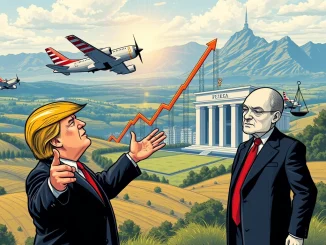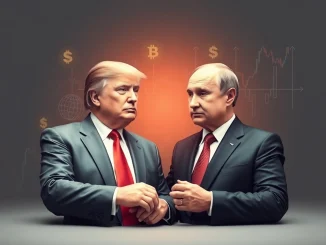
In the ever-watchful world of global finance and markets, even news seemingly unrelated to digital assets can send ripples. Understanding broader economic policy, like changes to US Tariffs, is key to grasping potential shifts in market sentiment that can indirectly influence the cryptocurrency space.
What’s the Latest on US Tariffs?
According to a statement from the Office of the U.S. Trade Representative (USTR), a significant decision point regarding existing tariffs is approaching. The current focus is on the 10% tariffs imposed on various countries. While discussions and evaluations of these measures are ongoing within government bodies, the ultimate call rests with one individual.
Trump Trade Policy: Where Does the Buck Stop?
The USTR has clarified that President Trump will be the final arbiter on whether to pursue alternative measures related to these tariffs. This reinforces the centralized nature of Trump Trade Policy during his administration, where presidential directives often shaped the direction of international trade relations.
This means that any potential changes – whether it’s a move towards Tariff Reduction or other adjustments – will require his direct approval. The statement from the USTR, as reported by JinSe Finance, highlights this crucial step in the decision-making process.
USTR Decision: What Does This Statement Signify?
The USTR’s comment isn’t necessarily an announcement of imminent change, but rather a procedural clarification. It indicates that:
- Internal reviews of the existing 10% tariffs are happening.
- Alternative approaches to the current tariff structure are being considered.
- However, none of these alternatives can be implemented without President Trump’s explicit decision.
This USTR Decision statement underscores the gatekeeping role of the presidency in significant trade actions.
Will We See Tariff Reduction Soon?
The statement doesn’t provide a timeline or indicate the likelihood of Tariff Reduction or removal. It merely states that the option for alternative measures is on the table and subject to the President’s approval. Factors that could influence such a decision might include:
- Current economic conditions in the US and affected countries.
- Ongoing trade negotiations or diplomatic efforts.
- Political considerations.
Market participants and international observers will be watching closely for any further signals or developments.
The Lingering Question of the Trade War
While the statement specifically addresses the 10% tariffs and potential alternatives, it exists within the broader context of past trade tensions often described as the Trade War. Decisions regarding specific tariffs can be seen as individual battles or strategic moves within this larger economic landscape. A move towards reduction could signal a shift in approach, while maintaining or increasing them would reinforce existing stances.
What Does This Mean for the Big Picture?
While not directly tied to cryptocurrency technology, shifts in global trade policy can impact overall market confidence and economic stability. Major changes to US Tariffs could influence supply chains, inflation, and international relations, all of which can, in turn, affect investor sentiment across various asset classes, including digital ones.
For those following the markets, this USTR statement is a reminder that significant economic policy levers remain under consideration at the highest levels of government. Keeping an eye on these traditional economic indicators and policy decisions provides crucial context for the sometimes volatile crypto market.
In Summary
The USTR has confirmed that any potential alternative measures to lift or reduce the current 10% tariffs on affected countries hinge entirely on a decision by President Trump. This reinforces the centralized nature of Trump Trade Policy and means that while internal evaluations are happening, no changes are final until he gives the word. Monitoring developments on US Tariffs and potential Tariff Reduction remains important for understanding the broader economic climate.



